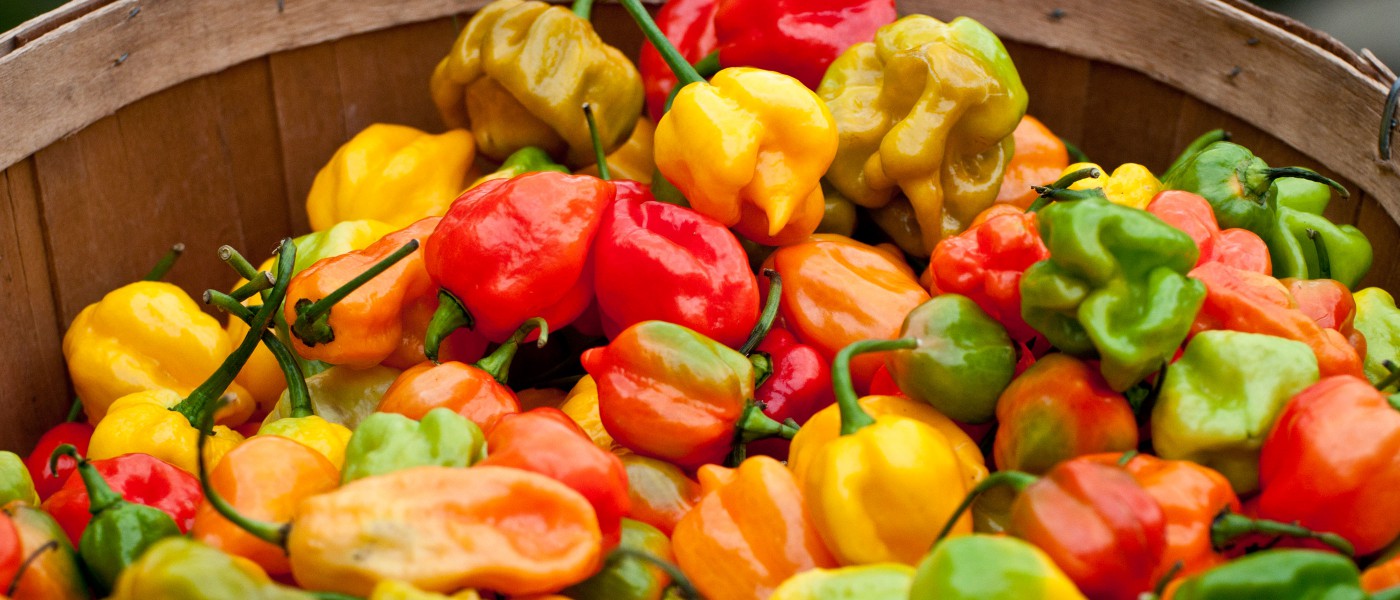Chile Peppers: Hot Tips and Tasty Picks for Gardeners and Gourmets
- Introduction: Of People and Peppers, by Beth Hanson
- The History of the Chile Pepper, by Paul Bosland
- What Makes Chile Peppers Hot?, by Paul Bosland
- Growing Chile Peppers, by Doug Dudgeon
- Growing Chile Peppers Indoors, by Susan Belsinger
- Disorders, Pests, and Diseases of Chiles, by Paul Bosland
- Preserving Chiles, by Susan Belsinger
- Encyclopedia of Chiles, by Paul Bosland
- Seed Sources
- Resources
- Contributors
- USDA Hardiness Zone Map
- Index
Introduction
Of People and Peppers
Beth Hanson
The partnership between people and the chile pepper is thousands of years old. In the latest phase of this partnership, electronic correspondence and commerce and modern marketing techniques all play parts. For years, a group of chile pepper devotees who called themselves "chile–heads" exchanged e–mail with recipes, tips for growing the hottest chiles, and help in finding the spiciest salsas. The number of aficionados grew, and, simultaneously, ethnic foods have become part of the American mainstream. More and more people developed a craving for chiles. Manufacturers and their marketing people found that chiles are an appealing design element and put them on mugs, tie racks, kitchen clocks, and strings of Christmas tree lights. Chiles crossed over, in a big way, into popular culture. On the Internet—a great place to gauge what's "hot"—you'll find the "Ring of Fire," a group of related web sites offering not only every variation on hot sauce and products like chile pepper cookie cutters, but also a huge variety of seeds, seedlings, and gardening information. Would–be purveyors of hot sauces and chile paraphernalia can even attend the "College of Chile Knowledge" every year in Albuquerque, New Mexico.
But chile peppers transcend the current trend. Whether or not Americans keep buying chile pepper posters and eating nachos and salsa, chiles will go on firing up the foods of people from Peru to Pakistan, as they have for centuries. Indigenous Americans first domesticated chiles about 7,000 years ago. Then, in the fifteenth century, Columbus "discovered" chiles, and they quickly traversed the globe on trading ships, finding a permanent place in foods everywhere they landed. On their travels, for example, they stopped in Korea and were incorporated into the fermented vegetable dish called kimchi. Koreans eat a lot of kimchi?and now they eat more chiles than any other people in the world: Chiles account for 12.5 percent of the daily food intake of the typical South Korean. The Turks brought chiles to the Balkans, where people bred them to reduce the pungency and to adapt them to the short growing season. In the form of paprika, chiles came to provide the color and flavoring of the Hungarian dish, goulash. Portuguese traders brought a few chile pods to India, giving curries of that part of the world their special flavor and pungency. Chiles are now essential to the cuisines of Asia, Africa, the Americas, and even parts of Europe. A quarter of the population of the globe eats hot chiles every day.
Chiles traveled round the world and were readily embraced for good reasons: They are vitamin powerhouses, each one packing more vitamin C than an orange. They are also rich in potassium, beta carotene, and fiber. And chiles contain compounds that some believe prevent cardiovascular disorders, certain forms of cancer, and cataracts. Their physiological power is evident to anyone who has consumed hot chile peppers in some form: The heart starts to beat rapidly, salivation and sweating increase, the nose begins to run, and the gastrointestinal tract goes into overdrive. To shut off the pain signals from the tongue, the brain secretes endorphins, the opiate–like substances that block pain. This experience may not sound like one to seek out again and again, but we do. Perhaps it's those endorphins that keep us coming back for more.
This book is a celebration of both the staying power of the chile in the world's gardens and cuisines, and of Americans' current enthusiasm for chiles. In the following chapter Paul Bosland, one of the world's preeminent pepper breeders, writes about the remarkable history of the chile and its journeys. Bosland is also the author of the "Encyclopedia of Chiles," (page 68), which includes more than 50 varieties, with tips on growing and preparing them, and ratings of how hot they are. In an extensive chapter on the pests and diseases that afflict chiles, Bosland discusses diagnosing and treating just about anything that may attacks chiles in gardens across the United States. Chile expert Doug Dudgeon spells out the basics of growing chile peppers, from germinating seeds to when and how to harvest. Susan Belsinger, chef, photographer, and writer, explains the best ways to preserve your chiles after the harvest, whether it's by pickling, drying, or freezing them. You'll also find a variety of recipes, from the savory to the sweet and almost all pungent. Finally, you'll find the sources for the best selections of chile seeds and expert advice.
Purchase
